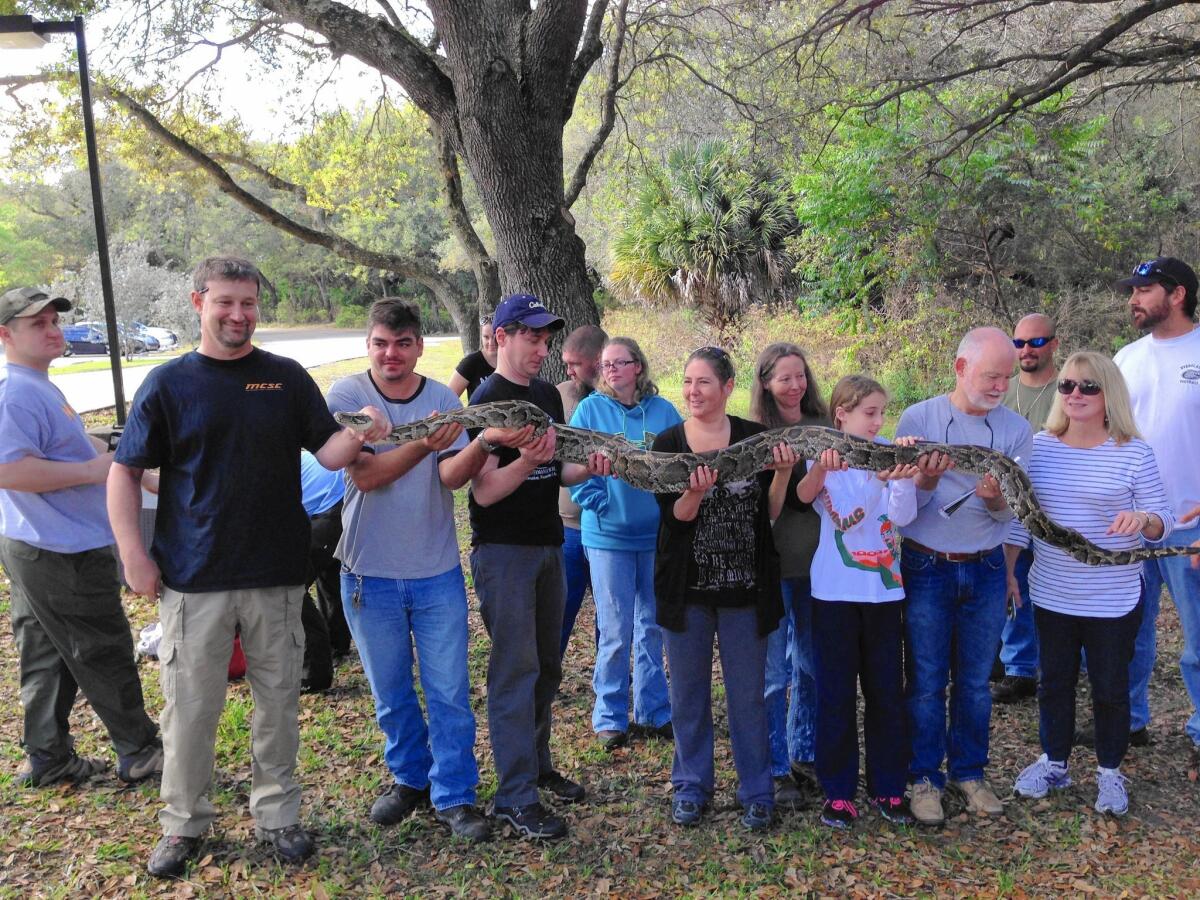Florida’s Python Patrol can show you how to be a snake wrangler

- Share via
reporting from DAVIE, Fla. — So you want to bag a Burmese python, the invasive serpent with giraffe-like markings that has turned the Florida Everglades into its personal buffet?
According to Florida officials, you need a snake hook (basically a pole with a bent end), two bags (cotton, not mesh), electrical tape and a secure container marked “Danger — dangerous reptiles.”
Also, you should attend snake school.
In recent weeks, the Florida Fish and Wildlife Conservation Commission has offered free Python Patrol training to residents willing to devote two hours to learning how to vanquish the scourge of south Florida wilderness. Hour one is the equivalent of “Intro to Snakes.” Hour two, a staffer unleashes the serpents.
That’s where program assistant Jeff Fobb comes in. As a recent group of students learned how to identify a serpentine invader (they’re larger and have different markings than native species), Fobb waited outside the hall with more than a dozen Burmese pythons, coiled like garden hoses in blue and white bags.
The nonvenomous Asian natives were first spotted here in 1979. Now thousands — likely tens of thousands — live in and around the Everglades, gorging on all kinds of mammals and birds and threatening to slither into other parts of the state. They even eat alligators. The largest one captured in Florida stretched 18 feet, 8 inches.
This state teems with hundreds of nonnative species. It’s home to Argentine black and white tegu lizards that gobble eggs and giant African land snails that chew stucco. Its ocean waters are home to lionfish, another predator from Asia that threatens native fish populations.
Burmese pythons have proved so ecologically ruinous that in 2013, the state held a Python Challenge, offering prize money to the most successful snake hunters.
Miami Herald columnist Dave Barry summed up the idea: “Would you like to make some extra money, and at the same time run the risk of being eaten by a carnivorous reptile the size of a war canoe?”
Over several weeks, hundreds of people — including U.S. Sen. Bill Nelson (D-Fla.) — fanned out across the southern half of the state with firearms and machetes.
Participants nabbed 68 pythons. But a single female python can birth 40 — every other year.
Some experts suspect Python Patrol training will prove just as futile. But wildlife officials figure it’s worth trying. Teaching people to spot the well-camouflaged snakes could help officials better track them. In snake school, you’re repeatedly reminded to report python sightings to a state exotic species hotline, (888) IVE-GOT1.
On a recent Sunday, close to two dozen people drove to Tree Tops Park in Davie, a suburban enclave about 25 miles north of Miami. At the park entrance, a board listed the day’s events: picnics, birthday parties, baby showers, python training. As with the Fish and Wildlife Conservation Commission’s other sessions this year, the python training had quickly filled up; afterward, participants who also completed online training could apply for a permit to trap pythons from some state lands.
Participants ranged from an 11-year-old boy to retirees in their 70s, all heeding the dress code of long pants and closed-toed shoes. One man wore head-to-toe green camo. Few had crossed paths with a Burmese python, but everyone easily recited recent headlines: The python found with dozens of eggs inside. The python that swallowed a deer.
Stan Daemer, 71, tangled with a blue indigo snake years ago on a dare. He wasn’t keen to face off with a python, but he spends time in the Everglades and wanted to learn what to do if he spotted one. Melinda Munger, 68, was concerned enough that she would stumble on one while hiking that this was her second snake school — she’d arrived late to the last one.
“I like snakes, actually,” she told Daemer before class.
He grimaced.
After the lecture portion of the class, Jenny Novak — “Python Patrol Leader,” per her business card — explained the niceties of wrangling a python. It’s remarkably similar to picking up dog poo. Once you’ve pinned the snake — a process unto itself — you grab it behind the head with a bag-covered hand. Then you pull the bag away from you and over the snake.
“Any questions?” Novak asked.
“What do you do if they bite you?” a woman said.
One by one, each wrangler grabbed a snake by the tail, dragged it back, pinned its head and bagged it. It took less time than a bathroom break. A woman called to snake wrangler No. 3, “How’s the jaw feel?”
“Surprisingly flimsy,” he replied.
Snake wrangler No. 7 hesitated. Most people did. Fobb warned him, “If you want to do a small snake, go now.”
The python was 5 feet long — at least. Someone in the group whispered, “That’s small?”
Compared with the snakes to come, yes.
As the hour wore on, nerves eased. Some people edged toward the snakes to snap better pictures. A few cracked jokes.
No. 11 quickly pinned his python. The woman with him shouted, “Good job! I ain’t doing it!”
Daemer was No. 12. He dropped to his knees and eased the snake into a blue bag. He smiled.
“We’re gonna make boots out of you,” he said.
After a few more wranglers, snake school concluded. There were no injuries — to snakes or humans — though one wrangler did get sprayed with python urine.
Before everyone drove off, Novak snapped a class photo: a line of Floridians, beaming, gripping an unfurled 13-footer.
More to Read
Sign up for Essential California
The most important California stories and recommendations in your inbox every morning.
You may occasionally receive promotional content from the Los Angeles Times.













